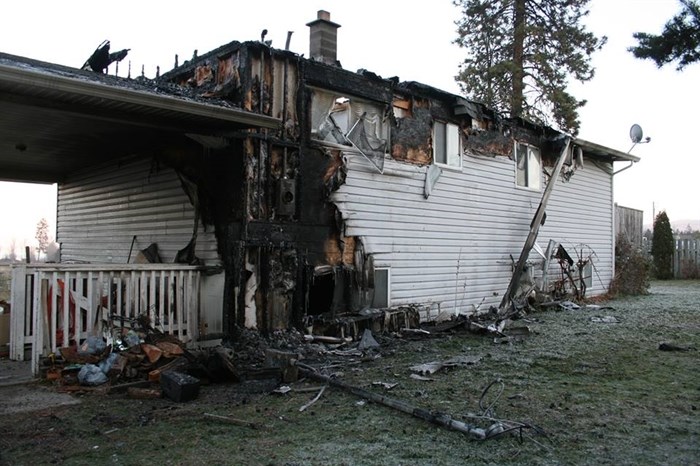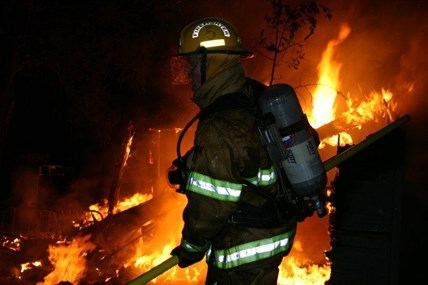
Aftermath of a fire on the Okanagan Indian Band reserve in 2013.
Image Credit: FACEBOOK/Okanagan Indian Band Fire Rescue
March 28, 2018 - 6:30 PM
“THIS CREATES A ‘FREE-FOR-ALL’ ENVIRONMENT THAT WE ARE NO LONGER WILLING TO WORK UNDER”
OKANAGAN - When firefighters put their lives on the line to save people or property, they expose themselves to dangerous fumes, flames, traffic hazards and more. In most parts of the province, there are mandatory safety requirements to mitigate these risks. But volunteer firefighters at the Okanagan Indian Band say many of their members didn’t even have the most basic of protective equipment, in the worst of cases showing up to scenes in running shoes and baseball caps.
You’d think that would be a signal for WorkSafe B.C., the provincial agency that looks after the health and safety of workers. But as our investigation into firefighter concerns at Okanagan Indian Band Fire Rescue reveals, WorkSafe B.C. doesn’t have jurisdiction to enforce safety laws on First Nations reserves, and they’re not the only regulatory body barred from lifting a finger.
Earlier this month, the Okanagan Indian Band confirmed it was conducting an independent review prompted by a letter from some members of the fire department outlining what the band called in a media release “possible deficiencies.” iNFOnews.ca has since obtained a copy of the lengthy letter, which makes 11 recommendations. It talks of members showing up to scenes without proper protective equipment or training, lack of qualifications to use equipment, and in some cases allegedly arriving intoxicated. Sources who spoke to iNFOnews.ca say seven firefighters resigned over the issues in the past two months, and two more were fired. While the band says “up to two dozen” volunteer firefighters remain available for emergencies, sources say that’s unlikely given the number of resignations. They claim there aren’t enough trained firefighters to adequately respond if an emergency arose on the reserve.

Image Credit: Okanagan Indian band Fire Rescue
DYSFUNCTION WITHIN THE DEPARTMENT
Sources say members were given outdated and poorly fitting personal protective equipment such as helmets, flame retardant coveralls, gloves and boots.
“It was a free for all when it came to gear — whatever we had in the back, give it to them,” one source tells iNFOnews.ca.
Members might attend calls wearing gloves with holes in them, masks that didn’t fit, and coveralls that were so big they became tripping hazards. New gear was ordered periodically, but typically took months to arrive, and there wasn’t enough to go around, sources say.
Training was another concern. Sources say some members were attending calls without proper emergency training. Some new recruits waited more than a year to receive training, but still attended and assisted with calls, putting everyone on scene at risk, they say.
Sources also allege junior firefighter recruits were attending emergency scenes and witnessing traumatic incidents. They’re recommending that junior firefighters not attend emergency calls until they are 18 years old.
“We, as the pillars of our department absolutely refuse to subject what are basically “kids” to the things we see at our emergency scenes any longer,” members state in the letter to council. “Even as adults, some of us are not prepared for what is on the other end of the 911 call when we arrive.”
The firefighters behind the letter claim the practices being taught at the fire hall are dangerous to their well being, and the community’s, and are refusing to work in the “free for all environment” any longer.
“Our image is tarnished and our reputation is battered. Our firehall is a pigsty, our trucks are always filthy. Our emergency scenes are chaotic and unorganized due to lack of leadership and resistance to change. We are looking for an opportunity for that change, and an opportunity to make our Fire Department something other than a burden,” they say in the letter. “Our new recruits, and some members keep asking when they are going to learn something, and when we will get the change we have been promised for too long already. We are asking the same. We are asking for structure, a qualified team of leaders, and to be equal with the departments around us in the fire service industry.”
NO EXTERNAL ENFORCEMENT OF SAFETY REGULATIONS
While it might seem heavy handed to send a letter to the band council with their concerns, firefighters had few other options. WorkSafe B.C., for instance, has no jurisdiction when it comes to inspections and enforcement on First Nations land, spokesperson Trish Knight Chernecki says. That’s all covered under federal jurisdiction. The only thing WorkSafe can do is open a file if a worker, including a firefighter, makes a claim for a work-related injury.
Fire protection services on reserves are managed by band councils, with core funding from Indigenous and Northern Affairs Canada. It’s a flawed system, according to Blaine Wiggins, executive director of the Aboriginal Firefighters Association of Canada.
“Unlike non-First Nation communities, there are no standards to adhere to,” Wiggins says.
In addition to WorkSafe B.C., Wiggins says reserves are also outside the jurisdiction of other provincial agencies like the Office of the Fire Commissioner. For example, the 2014 mandatory minimum training standards ‘Playbook’ for B.C. fire departments — which came after an inquiry into the death of a volunteer firefighter in Clearwater — is not enforceable on reserves.
Instead, it's up to bands to come up with their own policies, Wiggins says. They can choose to voluntarily subscribe to WorkSafe B.C’s policies, Wiggins says, but he has no idea how many do so.
“Ninety per cent of the problem is we don’t know the extent of the problem. There is no research, no information,” Wiggins says.
The agency that funds fire services on reserves — Indigenous and Northern Affairs Canada — is just that, a funding agency.
“It’s not a regulatory agency, it just writes the cheques,” Wiggins says.
Wiggins estimates that most reserve fire departments in B.C. — of which there are 60, according to Indigenous Affairs — are struggling, but says there are some exceptions.
“We have these pockets of excellence that have developed really well run, well funded departments. The majority are based in areas where they have a good economy, and revenue streams other than Indigenous and Northern Affairs Canada,” Wiggins says. “The biggest indicator is the need to protect that economy too; if you’re a business wanting to do business on First Nations land, you’re not going to go there if there is a fire risk. Many First Nations communities have realized that and invested.”
He says his association is listening to members like those who have spoken out from within the Okanagan Indian Band fire department.
"We certainly support when rank and file of a department identifies a problem and takes action to resolve it," he says. "It’s a sign there's some concern and momentum to address the issue in the community.”
Okanagan Indian Band chief Byron Louis declined multiple requests for an interview. In an earlier statement released to the media, the band pointed to underfunding of First Nations fire departments as a chronic issue but did not specifically address the allegations in the letter.
“It should be noted that many First Nations fire departments across Canada are dealing with similar issues due to significant underfunding. The lack of funding for many First Nations fire departments results in a dire need of equipment, essential training, and related support. Despite the lack of funding, the OKIB commits a substantial amount of its own resources to ensure that it has an operational volunteer fire department,” the band said.
Indigenous and Northern Affairs told iNFOnews.ca it provided just over $41,500 to the Okanagan Indian Band for fire protection services for 2016/2017 — money that is used at the band council’s discretion for things like fire trucks, training and maintenance of fire halls.
“The level of funding is determined by regionally based formulas, which take into consideration a number of factors such as the number of buildings on reserve, remoteness, population and environmental factors,” Indigenous Affairs says in a written response provided to iNFOnews.ca.
The statement goes on to say that Indigenous Services Canada “remains steadfast” in its commitment to create an Indigenous Fire Marshal’s Office and is “working closely” with the Aboriginal Firefighters Association of Canada on cost and timelines.
“The (Fire Marshal’s) Office will provide support to Indigenous communities in order to protect people, property and environment,” it says.
'NOTHING EVER HAPPENS'
According to the March 14 statement, the band “immediately secured an external expert advisor, who has no ties with OKIB council, administration, or the fire hall” to conduct an independent review into the firefighters’ concerns.
“The review will help identify safety issues, training needs, and resource gaps,” the band said.
The band declined to provide any further updates on the review to iNFOnews.ca, including whether or not it has been completed and what may result from it.
Sources, meanwhile, are not optimistic their efforts will bear fruit.
“After a few years of being with them, it’s always ‘oh yeah we want to do this, we want to do that’ and everyone gets hyped but nothing ever happens. Everything’s been talked about, nothing’s been implemented.”
To contact a reporter for this story, email Charlotte Helston or call 250-309-5230 or email the editor. You can also submit photos, videos or news tips to the newsroom and be entered to win a monthly prize draw.
We welcome your comments and opinions on our stories but play nice. We won't censor or delete comments unless they contain off-topic statements or links, unnecessary vulgarity, false facts, spam or obviously fake profiles. If you have any concerns about what you see in comments, email the editor in the link above.
News from © iNFOnews, 2018